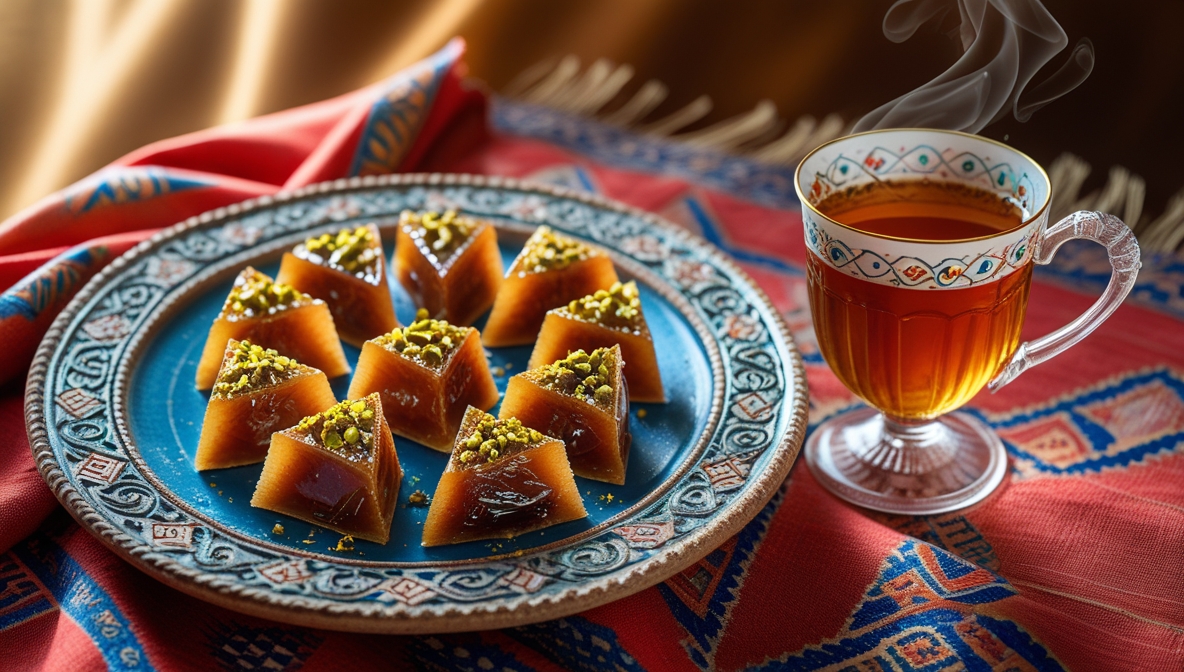Introduction
Golden, flaky, sweet, and rich — this iconic dessert is one of the most famous foods in Turkey. With its crunchy layers, aromatic nuts, and honeyed syrup, Baklava captures the heart of Turkish cuisine. Whether enjoyed in a local bazaar or an elegant Istanbul café, it’s more than just a treat — it’s a delicious representation of culture and tradition.
Loved by locals and travelers alike, this layered delight is a staple of Traditional Turkey Food and an experience to savor.


History & Cultural Significance
Though similar desserts were found in ancient Mesopotamia and Persia, the refined version of Baklava was perfected in the royal kitchens of the Ottoman Empire, especially in the Topkapı Palace. There, chefs turned it into an art form worthy of sultans.
In Turkish culture, this dessert is often served during Eid, weddings, and major festivals. It’s a symbol of celebration and hospitality — a dish shared with loved ones to honor long-standing traditions.
Ingredients & Regional Variations
Core Ingredients:
Phyllo dough (paper-thin pastry sheets)
Chopped nuts (pistachios, walnuts, or hazelnuts)
Butter
Sugar syrup or honey
Optional hints of lemon juice, rosewater, or cinnamon
Regional Highlights in Turkey:
Gaziantep-style Baklava: Pistachio-rich, with EU-protected status — a true showcase of Traditional Turkey Food.
Walnut Baklava: A favorite in central Anatolia.
Sütlü Nuriye: A lighter version made with milk for a creamier taste.
Modern Twists:
Chocolate-drizzled
Vegan options (coconut oil + agave)
Gluten-free (using rice paper or almond flour)
Cooking Process & Difficulty Level

Skill Level: Intermediate to Advanced
Best Recipe – Basic Steps:
Prepare a sugar-lemon syrup and let it cool.
Layer phyllo dough in a greased tray, brushing with melted butter.
Sprinkle chopped nuts every few layers.
Repeat layers, then slice into diamonds or squares.
Bake until crisp and golden.
Pour the cooled syrup over the hot pastry.
Let it soak and cool before serving.
Tip: Keep unused phyllo sheets covered with a damp towel to prevent drying out.
Where to Eat Baklava in Turkey
Looking for Best Place to Try while visiting Turkey? Here are top spots for authentic experiences:
Güloğlu Baklava (Istanbul) – A legendary destination for pistachio lovers.
İmam Çağdaş (Gaziantep) – A heritage spot famous for traditional Antep-style sweets.
Karaköy Güllüoğlu – A pilgrimage site for dessert enthusiasts.
Hafız Mustafa (Istanbul) – Serving exquisite desserts since the 1860s.
These spots offer the ultimate way to explore one of the most famous foods in Turkey.
What to Drink & Serve with It
Perfect Pairings:
Strong Turkish tea (classic)
Turkish coffee (for contrast)
Ayran or dry white wine (to balance sweetness)
Side Ideas:
Fresh melon or grapes
Clotted cream (kaymak)
Vanilla or pistachio ice cream
Fun Facts You Probably Didn’t Know
Gaziantep is officially recognized as the world capital of Baklava.
Ottoman sultans used to present it to Janissaries in ceremonial processions.
Legend says Napoleon Bonaparte enjoyed an early version of it.
Health & Nutritional Aspects
Though indulgent, this dessert can offer:
Healthy fats from nuts
Antioxidants from pistachios and walnuts
Energy-boosting carbs
Healthier Takes:
Vegan versions with olive oil and agave
Low-sugar alternatives using date syrup
Gluten-free varieties made with rice paper
The Best Baklava Recipe (For Home Cooks)
You’ll Need:
1 package of phyllo dough
2 cups chopped pistachios or walnuts
1 cup melted butter
1 cup sugar
1 cup water
1 tbsp lemon juice
Cinnamon (optional)
Steps:
Preheat oven to 175°C (350°F).
Layer phyllo sheets with butter in a baking tray.
Add nuts every few layers.
Cut into diamonds or squares.
Bake for 45 minutes.
Pour cooled syrup over the hot pastry.
Let it rest and absorb the syrup.
Pro Tip: Add a few drops of rosewater to the syrup for a fragrant twist.
Baklava’s Global Reach & Fusion Flair
This dessert has inspired many sweet treats worldwide:
Greek versions use more honey and walnuts.
Middle Eastern desserts like Ma’amoul borrow from its spirit.
Trendy fusions:
Baklava cheesecake
Baklava cupcakes
Ice cream sandwiches
Similar Dishes Across Cultures
Greek Baklava: More honey-forward with heavier walnut use.
Strudel: Fruit-filled, fewer layers.
Ma’amoul: Date-filled cookies, not layered.
Mille-Feuille (France): Cream-based, lighter texture.

